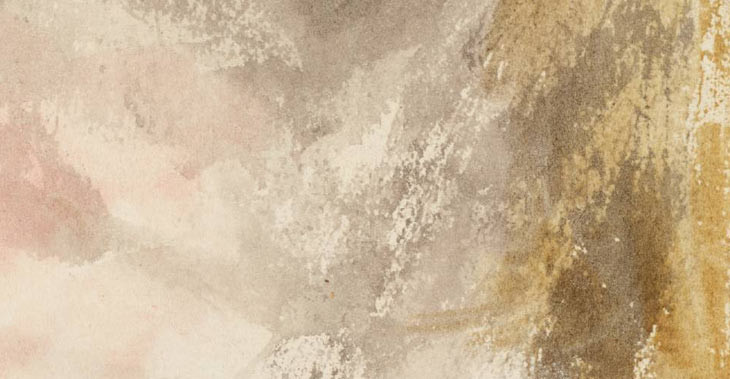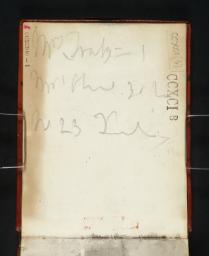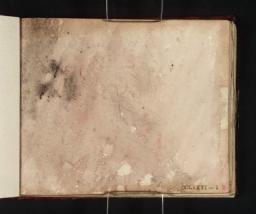Erotica and Improvisations c.1834–6

From the entry
Three small sketchbooks, of similar sizes and bound in red leather, are grouped together here on account of the watercolour studies they contain, which are spontaneous to a degree, albeit within a relatively narrow technical range. Many of those in the two so-called ‘Colour Studies’ books are overtly erotic and occasionally explicit, ‘once the eye and mind adjusts to Turner’s mode of expression’, as Ian Warrell has put it. The contents of Fishing at the Weir are the most miscellaneous, including conventional pencil sketches of river and coastal scenes, but there are enough pages of watercolours, made in a similarly improvisational style to those which characterise the two other sketchbooks, to justify treating the three books together. Warrell has noted that Turner’s Colour Studies sketchbooks ‘permit us to understand the extent to which he was able to find erotic stimulation from indistinct arrangements of tone and colour’. About half of the ...
Fishing at the Weir Sketchbook c.1834–6
D27727–D27731, D27733–D27744, D27746–D27749, D27751–D27753, D27755–D27778, D27780–D27784, D27786–D27791, D40746–D40748
Turner Bequest CCLXXXI 1–35
D27727–D27731, D27733–D27744, D27746–D27749, D27751–D27753, D27755–D27778, D27780–D27784, D27786–D27791, D40746–D40748
Turner Bequest CCLXXXI 1–35
Colour Studies (1) Sketchbook c.1834–6
D28791–D28816, D28818–D28829, D28831–D28832, D28834–D28835, D28837–D28838, D28840–D28841, D28843–D28844, D28846–D28847, D28849–D28853, D28855–D28861, D28863, D28865, D28867, D28869, D28871, D28873
Turner Bequest CCXCI b 1–56
D28791–D28816, D28818–D28829, D28831–D28832, D28834–D28835, D28837–D28838, D28840–D28841, D28843–D28844, D28846–D28847, D28849–D28853, D28855–D28861, D28863, D28865, D28867, D28869, D28871, D28873
Turner Bequest CCXCI b 1–56
Colour Studies (2) Sketchbook c.1834–6
D28874–D28886, D28888, D28890, D28892, D28894, D28896, D28898, D28900, D28902, D28904, D28906, D28908, D28910, D28912, D28914, D28916, D28918, D28920, D28922, D28924, D28926, D28928, D28930, D28932, D28934, D28936, D28938, D28940, D28942, D28944, D28946, D28947, D41220, D41221
Turner Bequest CCXCI c 1–42
D28874–D28886, D28888, D28890, D28892, D28894, D28896, D28898, D28900, D28902, D28904, D28906, D28908, D28910, D28912, D28914, D28916, D28918, D28920, D28922, D28924, D28926, D28928, D28930, D28932, D28934, D28936, D28938, D28940, D28942, D28944, D28946, D28947, D41220, D41221
Turner Bequest CCXCI c 1–42
References
Three small sketchbooks, of similar sizes and bound in red leather, are grouped together here on account of the watercolour studies they contain, which are spontaneous to a degree, albeit within a relatively narrow technical range. Many of those in the two so-called ‘Colour Studies’ books are overtly erotic and occasionally explicit, ‘once the eye and mind adjusts to Turner’s mode of expression’, as Ian Warrell has put it.1 The contents of Fishing at the Weir are the most miscellaneous, including conventional pencil sketches of river and coastal scenes, but there are enough pages of watercolours, made in a similarly improvisational style to those which characterise the two other sketchbooks, to justify treating the three books together. Warrell has noted that Turner’s Colour Studies sketchbooks ‘permit us to understand the extent to which he was able to find erotic stimulation from indistinct arrangements of tone and colour’.2 About half of the works reproduced in Warrell’s most comprehensive treatment of the erotica in the Turner Bequest are from the two books;3 as he has observed, the only other similarly focused sketchbook is the rather earlier Academy Auditing book (Tate; Turner Bequest CXX a), which comprises dozens of unambiguous pencil studies.4
Fishing at the Weir also includes slight London sketches, showing the old Houses of Parliament after the fire of October 1834. These were presumably made soon afterwards, and can be linked to the composition of the substantially complete watercolour of The Burning of the Houses of Parliament which remained in Turner’s studio (Tate D36235; Turner Bequest CCCLXIV 373). In the absence of watermarks or any other precisely datable subjects these, together with topographical notes in the same book which seem to relate to a tour of 1836, are keys to the approximate dating of the whole group; in addition, Colour Studies (1) contains what may be studies for a painting exhibited in 1836 or vignette watercolour illustrations of the mid 1830s, engraved in 1837. Each sketchbook has therefore been dated here to about 1834–6.
Warrell has suggested that the less-developed watercolour compositions in the Fishing at the Weir book may not be of an erotic character.5 However, the three books have been considered as a coherent sequence by Raphael Rosenberg among others; he supposed that Colour Studies (2) was filled first, followed by Colour Studies (1), and concluding with Fishing at the Weir, where the watercolours petering out after the first few pages,6 although the actual order is effectively unrecoverable. Lawrence Gowing had been the first to link them, in the context of his exploration of Turner’s later career:
One of the most significant developments was the most private; it is contained in three little sketchbooks, closed with metal clasps. One of the three already contained some pencil drawings of people fishing at a weir. His next use of the books was quite unconnected with them, or at first sight anything else. Red and grey washes were swept across the pages, more and more broadly until leaf after leaf held torrents of sombre colour, tiny enigmatic cataracts. In two of the books [Colour Studies (1) and (2)] naked figures begin to materialize out of the flux, and in one [Colour Studies (1)] it becomes possible to construe the scenes. They are scenes of love in curtained beds, some passionate, others dark and strangely desolate. The dark floods of tone were to become an essential element of Turner’s later art, and they have an erotic meaning that was never displayed openly in pictures.7
As noted in more detail in their Introductions, A.J. Finberg thought that either of the Colour Studies books might have been the source of paper to make sails for a child’s toy boat at Petworth House in about 1834.8 For about a decade before his host’s death in 1837, Turner regularly stayed at the great Sussex house as a guest of his patron the Earl of Egremont, although their association went back to the 1800s.9 Egremont was a welcoming, somewhat Bohemian figure and the house had a reputation for its free and easy atmosphere; the artist appears to have had access to the various bedrooms, with their rich furnishings and curtained beds, characterised particularly in fifteen of a wider series of lively gouache studies on blue paper, which sometimes show women in these intimate settings (Tate; Turner Bequest CCXLIV).10 Together with Finberg’s more mundane anecdote, this similarity in subject matter has sometimes led to the contents of the Colour Studies books being associated with Petworth to varying degrees.11 As Andrew Wilton has noted, there ‘need not, in fact, be any connection’,12 and the scenes are probably in effect imaginary,13 although the possibility of Turner drawing in brothels is not ruled out.14 As well as the circumstantial ‘evidence’ of these and other sketches, the latter scenario stems ultimately from Thornbury’s 1862 biography of the artist, where ‘on only too good authority’ he was said after a hard week’s painting ‘to set off to some low sailors’ house in Wapping or Rotherhithe, to wallow till the Monday morning’.15
To Gerald Wilkinson, the Colour Studies images ‘belong to a private world of Turner’s where colour smudges could be turned into poetry, like pictures in the fire’, describing the Colour Studies (1) sketchbook as ‘claustrophobic, some of the pages very heavily worked with layers of dark watercolour. A great painting of Turner’s may seem to open up and expand before us: this miniature closes us in, mysteriously suggesting in half-revealed images some truth which he could not paint.’16 Warrell has described the general ‘mood’ Colour Studies (2) as ‘lighter than its pair’.17 Anthony Bailey has observed that at ‘fifty-nine or so [Turner] still had a powerful sex-drive, although he didn’t seem altogether free about revealing it, even for his own viewing. Most of these “studies” are not well drawn; only a part of him seems involved. Some have a voyeuristic feeling’.18 The American psychiatrist Dr Joseph William Slap has assumed a Petworth connection and speculated that despite his success, Turner’s lack of education and social standing meant that despite being on amicable terms with Lord Egremont he could not ‘mix comfortably with the high-born ladies and gentlemen who cavorted in this palatial setting’, but could ‘only look and envy’, retreating to his studio where his ‘desire to look and to represent the erotic and eroticized life at Petworth met with resistance’, so that his representations ‘became blurred, out of focus, and attention shifted to light and color’.19
Slap sees this stylistic change more widely in the later work, with ‘the same deterioration of form, frequently with the appearance of an intervening screen of fog, haze, smoke or precipitation ... analogous to symptoms ... in clinical practice which I have described as “waking screens” and which [American psychoanalyst Phyllis] Greenacre has called “walls of denial.”’ Influenced by his reading of Gowing, Slap attributes this to the artist defending himself against traumatic ‘stimulation, to turn away, to lose focus, ultimately to sleep – all this is represented by the loss of detail and the interposition of a screen.’20 In a similar vein, Anthony Bailey has described the studies, many of which show actual bed curtains, as ‘coloured mists or curtains, almost, that are waiting to be lifted or pulled’,21 while Jack Lindsay has speculated that ‘the dark-toned bursts in Turner’s later work held for him an emotional suggestion of such obscurely hidden embraces and tumbling encounters, desperate, fading away into a lost isolation of brooding satisfaction and frustrations’.22
In more conventional artistic terms, Andrew Wilton has described the ‘allusive, shadowy’ wash studies as ‘of much greater aesthetic interest than most of the ... slight erotic scribbling to be found in the Turner Bequest’.23 He has noted Turner’s renewed interest in Rembrandt’s24 use of light and shade in the early 1830s,25 and in connection with this he has also mentioned Turner’s friendly rivalry at that time with Thomas Jones (1786–1869), an ‘unashamed borrower of Rembrandt’s chiaroscuro’, suggesting that Turner was here ‘making use of the dark inky blues and browns favoured by Jones in his drawings of historical subjects’.26 Gowing had discussed them27 in conjunction with the unresolved painting Death on a Pale Horse (?) of about 1825–30 (Tate N05504),28 where the image ‘materializes out of a drifting cloud’.29 John Gage made the same connection in terms of the painting’s thin glazes, subjected to rubbing and scraping30 to a degree described by Martin Butlin as ‘unparalleled in Turner’s oils’.31
Turner’s method of composition for his watercolours in the 1820s and 1830s had increasingly involved the use of ‘Colour Beginnings’ in which he would block in the main forms and tones, sometimes on several variant sheets, as an adjunct to his detailed topographical pencil touring sketches before embarking on the definitive, highly detailed composition (see for instance the ‘Colour Studies Relating to ‘Picturesque Views in England and Wales’ c.1825–39’ section of this catalogue). Occasionally erotic elements appear in Turner’s private landscape watercolours: Ian Warrell has compared the ‘suggestive, but blurred, forms’ of the entwined figures in the Colour Studies books with those apparently merging with or emerging from the landscape in a watercolour traditionally known as ‘?On the Loire’ (Tate D36219; CCCLXIV 357), but possibly relating to River Mosel subjects of 1839; it is inscribed ‘Love and strewn [or ‘green’] leaves’.32
Gage has mentioned drawings in these and other sketchbooks ‘with all the character of blots’, alluding to the concept of the ‘blot’ as a means to composition, formalised by the artist Alexander Cozens (1717–1786)33 in his 1786 New Method of Assisting the Invention in Drawing Original Compositions of Landscape 34 and Mrs Gartside’s Essay on a New Theory of Colours (second edition, 1808): ‘Yet it is precisely in these books that we are closest to Turner’s need to be specific, his care for controlled expression, and the element of improvisation is minimal’, since Turner had ‘little desire or need for what Cozens called landscape “invention”.’35
Rosenberg has ascribed Turner’s relatively ‘abstract’ approach here to a combination of deliberate ambiguity to stimulate the imagination of the viewer – in this instance presumably Turner alone – and an experimental approach in the use of formal elements.36 He has noted that in these studies Turner moves between the poles of representation through the use of pencil and drawing in watercolour with a fine brush, and abstraction through blots which were developed subsequently, albeit with a preconceived general subject.37 Without rehearsing the largely discredited idea of Turner as a proto-Modernist38 (based often on unfinished works and working material not intended for exhibition), in terms of contemporary art a comparison can be made with Francis Bacon (1909–1992), an essentially figurative painter of often erotic subjects, who set great store by spontaneity (within limits); he expressed this in his ‘painter’s tribute’ to Matthew Smith (1879–1959): ‘He seems to me to be one of the very few English painters since Constable and Turner to be concerned with painting – that is, attempting to make the idea and technique inseparable. Painting in this sense tends towards a complete interlocking of image and paint’.39
As Warrell has noted, in the Colour Studies (1) book there are various double-page spreads treated with wash offset from side to side (see its Introduction for the specific cases). To summarise Rosenberg’s German text on this issue: probably by chance, Turner had turned over a page when the colour was still so wet that an imprint was left on the opposite side (especially at the gutter); the initial image created was not figurative as such; it is unclear whether Turner was intending to leave some of the pages at that stage or to revise them subsequently; in some sense Turner has used a technique of Klecksography before the term was coined.40 It comes from the illustrated book of Klecksographien (from the German ‘Klecks’, a smudge) by the doctor and poet Justinus Kerner (1786–1862), who generated random symmetrical images through folding ink blots; the best-known practitioner of the technique was the Swiss Freudian psychologist Hermann Rorschach (1884–1922), who used such images to categorise his patients according to what they considered the supposedly abstract marks to be.41 In Turner’s case, while visual evidence of their common origin remains, the two halves of the image were generally developed in different ways: see for example Tate D28835, D28837 (Turner Bequest CCXCI b 35, 36).
As early as 1799, Turner reportedly had ‘no systematic process for making Drawings – He avoids any particular mode that He may not fall into manner. By washing and occasionally rubbing out, he at last expresses in some degree the idea in his mind’.42 However, as David Blayney Brown points out in his ‘Draughtsman and Watercolourist’ essay elsewhere in this catalogue: ‘Rather than mere improvisation, this implied an instinctive realisation of his pictorial ideas driven by the performance of the medium itself.’
See in particular Martin Butlin, Mollie Luther and Ian Warrell, Turner at Petworth: Painter and Patron, London 1989; and Christopher Rowell, Ian Warrell and David Blayney Brown, Turner at Petworth, exhibition catalogue, Petworth House, Petworth 2002.
See for example those reproduced in Rowell, Warrell and Brown 2002, pp.[160]–71; see also Warrell 2003, p.22.
See Wilton 1974, p.126; Wilkinson 1975, p.76; Wilton 1975, p.124; Wilton 1977, p.45; Wilton 1983, p.[239]; Warrell 1989, pp.146–7; Warrell 1991, p.62; Warrell 2001, p.227; Warrell 2003, p.22; Wilton 2006, pp.119–20; and Rosenberg 2007, p.117.
Walter Thornbury, The Life of J.M.W. Turner, R.A. Founded on Letters and Papers Furnished by his Friends and Fellow-Academicians, London 1862, vol.II, p.168.
See Alfred (Fred) Bachrach, ‘Rembrandt van Rijn (1606–69)’ in Evelyn Joll, Martin Butlin and Luke Herrmann (eds.), The Oxford Companion to J.M.W. Turner, Oxford 2001, p.256–7.
As analysed in Sam Smiles, J.M.W. Turner: The Making of a Modern Artist, Manchester and New York 2007.
Francis Bacon in John Rothenstein and others, Matthew Smith: Paintings from 1909 to 1952, exhibition catalogue, Tate Gallery, London 1953, p.12.
For Kerner and Rorschach in the context of artists before and since including Cozens, see Christopher Turner, ‘The Deliberate Accident in Art: Blots’ [‘Tate Etc’, no.21, Spring 2011], Tate, accessed 10 April 2014, http://www.tate.org.uk/context-comment/articles/deliberate-accident-art .
How to cite
Matthew Imms, ‘Erotica and Improvisations c.1834–6’, May 2014, in David Blayney Brown (ed.), J.M.W. Turner: Sketchbooks, Drawings and Watercolours, Tate Research Publication, September 2014, https://www



